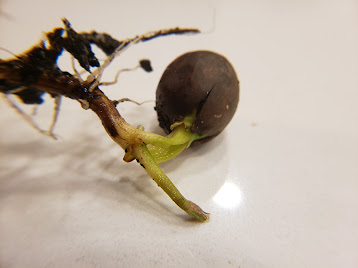An Early Acorn Seedling (Quercus Velutina)
One of the main challenges with growing native plants is the fact that they have adapted to only germinate in the spring, which makes evolutionary sense, because frost quickly kills young plants, and the seeds need to time their growth so that they are as mature and ready as possible for the winter. I sprouted at least one acorn every spring for the past two springs. Both times, it started with me flipping a log, and finding a little green sprout underneath it, which led to an acorn.
This time, I started it artificially. I wrapped it in a damp paper towel, to simulate the moist underground conditions it would naturally go through. I then placed that in a zip-lock bag, to keep the water from evaporating, and put the bag in my refrigerator. I left 4 acorns in that bag. Two white oak, and two black oak. I took one of each species out of the fridge and onto the warm soil which my striped wintergreen is growing on. Both acorns had spent almost 3 months in the fridge. This was to mimic a natural Massachusetts winter. The process is commonly called "Cold Stratification".
Black Oak (Quercus Velutina)
On the 27th, I was checking in on my Striped Wintergreen, which was doing fine. I noticed a new little green sprout coming out of the ground. As you can see above, my experiment was a success. The other acorn is just not beginning to open up, and is nowhere near the size of the images above.
In nature, the Acorn is typically put underground by gray squirrels, who stash hundreds of acorns under the leaf litter, and forget about most of them, providing the perfect conditions for germination.
This Spring, I will be the Grey Squirrel. I am going to do an update post every time there is a major change in the seedling, such as leaves opening, and height increase. Each update will include a photo from each previous post, so you can see the progression over time.



.jpeg)

Comments
Post a Comment